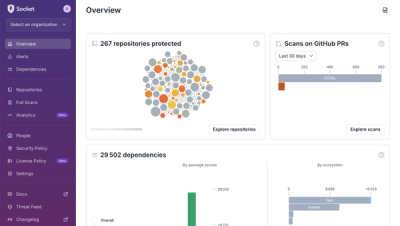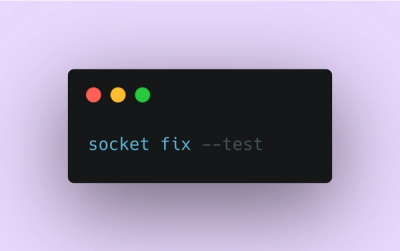
Product
A New Overview in our Dashboard
We redesigned Socket's first logged-in page to display rich and insightful visualizations about your repositories protected against supply chain threats.
@wdio/sync
Advanced tools
A WebdriverIO plugin. Helper module to run WebdriverIO commands synchronously
A WebdriverIO plugin. Helper module to run WebdriverIO commands synchronously
A WebdriverIO plugin. Helper module to run WebdriverIO commands synchronously. It overwrites global functions depending on the test framework (e.g. for Mocha describe and it) and uses Fibers to make commands of WebdriverIO using the wdio testrunner synchronous. This package is consumed by all wdio framework adapters.
If you are using the WDIO testrunner all you need to make all your specs run synchronous is to have @wdio/sync installed in your project. The testrunner automatically will detect it and transform the commands to make a test like this:
describe('webdriver.io page', () => {
it('should have the right title', async () => {
await browser.url('https://webdriver.io')
await expect(browser)
.toHaveTitle('WebdriverIO · Next-gen browser and mobile automation test framework for Node.js | WebdriverIO')
})
})
easier to read and write like this:
describe('webdriver.io page', () => {
it('should have the right title', () => {
browser.url('https://webdriver.io')
expect(browser).toHaveTitle('WebdriverIO · Next-gen browser and mobile automation test framework for Node.js | WebdriverIO')
})
})
Given you have a simple standalone WebdriverIO script like this:
// standalone.js
const { remote } = require('webdriverio')
const sync = require('@wdio/sync').default
;(() => {
const browser = await remote({
outputDir: __dirname,
capabilities: {
browserName: 'chrome'
}
})
await browser.url('https://webdriver.io')
console.log(await browser.getTitle())
await browser.deleteSession()
})().catch(console.error)
With this package you can make WebdriverIO commands synchronous by using the sync wrapper:
// standalone.js
const { remote } = require('webdriverio')
const sync = require('@wdio/sync').default
remote({
runner: 'local',
outputDir: __dirname,
capabilities: {
browserName: 'chrome'
}
}).then((browser) => sync(() => {
/**
* sync code from here on
*/
browser.url('https://webdriver.io')
console.log(browser.getTitle())
browser.deleteSession()
}))
While using @wdio/sync you can still switch between both by using the browser.call() command. It allows you to run async code and return the result into a synchronous environment. For example:
describe('webdriver.io page', () => {
it('should have the right title', () => {
/**
* synchronous execution here
*/
browser.url('https://webdriver.io')
const result = browser.call(async () => {
/**
* asynchronous execution here
*/
await browser.url('https://google.com')
return Promise.all([
browser.getTitle(),
browser.getUrl()
])
})
/**
* synchronous execution here
*/
console.log(result) // returns: ['Google', 'https://www.google.com/']
})
})
FAQs
A WebdriverIO plugin. Helper module to run WebdriverIO commands synchronously
We found that @wdio/sync demonstrated a not healthy version release cadence and project activity because the last version was released a year ago. It has 3 open source maintainers collaborating on the project.
Did you know?

Socket for GitHub automatically highlights issues in each pull request and monitors the health of all your open source dependencies. Discover the contents of your packages and block harmful activity before you install or update your dependencies.

Product
We redesigned Socket's first logged-in page to display rich and insightful visualizations about your repositories protected against supply chain threats.

Product
Automatically fix and test dependency updates with socket fix—a new CLI tool that turns CVE alerts into safe, automated upgrades.

Security News
CISA denies CVE funding issues amid backlash over a new CVE foundation formed by board members, raising concerns about transparency and program governance.